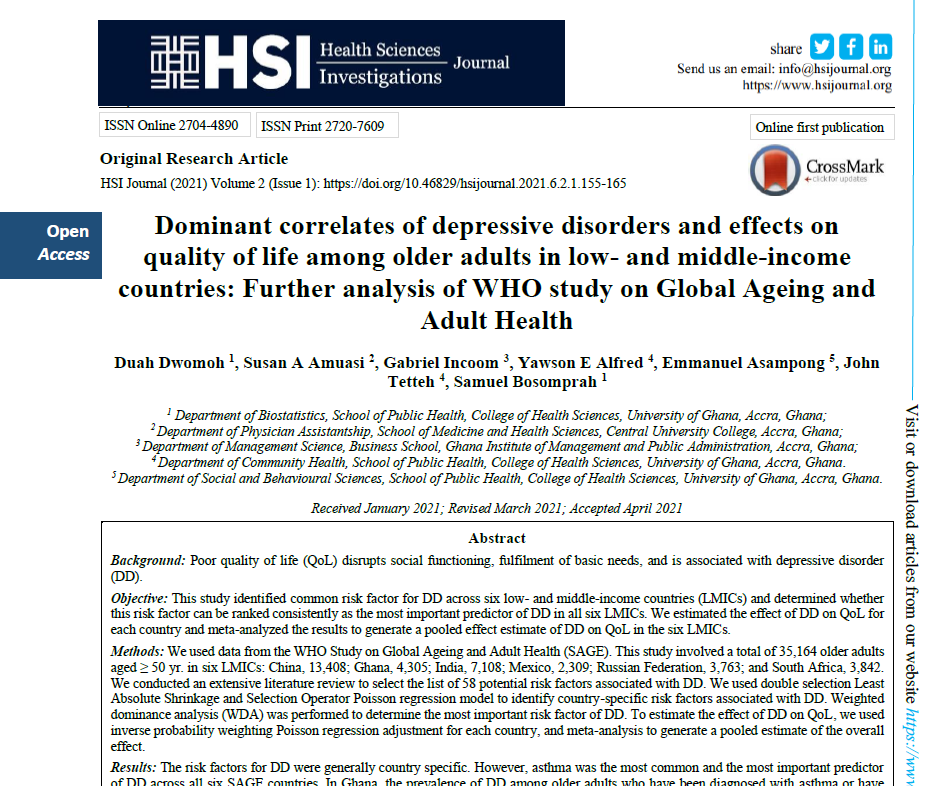Dominant correlates of depressive disorders and effects on quality of life among older adults in low- and middle-income countries: Further analysis of WHO study on Global Ageing and Adult Health
Depressive Disorders and Quality of Life
Abstract
Background: Poor quality of life (QoL) disrupt social functioning and fulfilment of basic needs, and are associated with depressive disorders (DD). We answered the question of whether there is a common risk factor of DD across six low- and middle-income countries (LMICs) and determined whether this risk factor can be ranked consistently as the most important predictor of DD in all six LMICs. We further estimate the effect of DD on QoL in for each country and meta-analyzed the results to generate pooled effect of DD on QoL in the six LMIC.
Methods : We used data from the World Health Organization’s (WHO) Study on Global Ageing and Adult Health (SAGE). This study involved a total of 35,164 older adults aged 50 years and older in six LMICs: China-13,408; Ghana-4,305; India-7,108; Mexico-2,309; Russian Federation-3,763; and South Africa-3,842. We conducted an extensive literature review to select the list of 58 potential risk factors associated with DD. We used double selection Least Absolute Shrinkage and Selection Operator Poisson regression model to identify country-specific risk factors associated with DD. Weighted dominance analysis (WDA) was performed to determine the most important risk factor of DD. To estimate the effect of DD on QoL, we used inverse probability weighting Poisson regression adjustment for each country, and meta-analysis techniques for a pooled estimate of the overall effect.
Results: The risk factors for DD were generally country-specific. However, Asthma was the most common and the most important predictor of DD across all six SAGE countries. In Ghana, the prevalence of DD among older adults who have been diagnosed with Asthma or have experienced symptoms of Asthma in the 12 months preceding the survey was 14 times that among those without Asthma or asymptomatic of Asthma (Adjusted Prevalence Ratio (aPR)=14.46, 95% CI: 10.47-19.97, p<0.001). Similarly, it was 14 times in South Africa (aPR=14.6, 95% CI: 8.18-26.14, p<0.00) but in Mexico, it was 4 times (aPR=4.39, 95% CI: 3.00-6.42, p<0.001) and in China (aPR=5.99, 95% CI: 4.32-8.31, p<0.001) and Russia (aPR=5.9, 95% CI: 3.9-9.0, p<0.001), it was 6 times. In India, it was 5 times (aPR=5.1, 95% CI: 4.3-6.0, p<0.001. Generally, there was evidence of 8% increase in poor QoL due to the presence of DD (Pooled estimate =0.08; 95% CI: 6.0-12, p<0.001). Specifically, in China, there was evidence of 12% increase in poor QoL that could be attributed to DD (prevalence difference (PD)=0.12; 95% CI: 0.07-0.18, p<0.001). In India (PD=0.08; 95% CI: 0.04-0.13, p<0.01) and Russian Federation (PD=0.08; 95% CI: 0.01-0.15, p<0.01), there was evidence of 8% increase in poor QoL. Although, there was some increase in poor QoL in Mexico, Ghana, and South Africa due to DD, the increase was not statistically significant.
Conclusion: Although different factors could explain the prevalence of DD among older adults in the six LMICs, it was evident that Asthma patients amongst this population were at a higher risk of DD. Clinical evaluation and potential diagnosis and treatment of DD among older adults who present with Asthma could potentially enhance their QoL.


